Samsung Galaxy S 4 Review - Part 1
by Brian Klug on April 24, 2013 12:01 AM ESTBattery Life and Charge Time
The Galaxy S 4 features a removable 9.88Wh battery with 3.8V chemistry. The battery design is par for the course for any high end smartphone, but the fact that it's removable remains a staple of the Galaxy S design. Whether or not the bulk of consumers actually use the flexiblity offered by a removable battery is up for debate, but there's no doubt about the fact that Samsung has a strong following of users who appreciate the feature.
Unfortunately, only having access to the Sprint version of the Galaxy S 4 to review, most of our battery life tests on the cellular network aren't all that useful. The good news is that our WiFi tests should at least give you an idea of how well the SGS4 will compare to the HTC One when both are on the same network. We're using the latest revision of our smartphone battery life test to compare performance of all the key players here. This is now our sixth revision of the battery life test, and we feel is the optimal balance between challenging workloads and idle time. The basic overview is the same as the previous test — we load webpages at a fixed interval until the handset dies, with display set at exactly 200 nits as always. Power saving features are disabled if they turn on automatically, and background account sync is disabled. The test is performed over both cellular data on all available air interfaces and over WiFi in an environment with good signal levels. The new test has decreased pause time between web page loads and added a number of JavaScript-heavy pages. I sat down with some UMTS RRC (Radio Resource Control) emulator tools and also made sure we had a good balance of all the RRC states (DCH, PCH if possible, FACH, IDLE) so we weren’t heavily biased towards one mode or the other.
As the most relevant comparison of platforms we have today, we'll start with the WiFi version of our web browsing test:
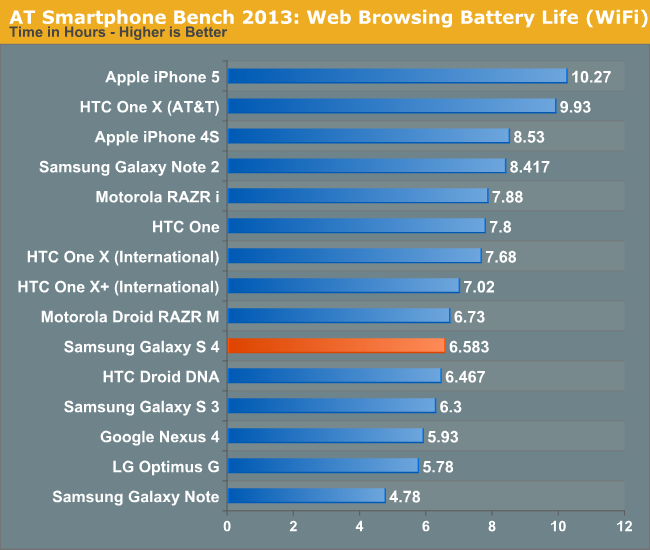
On WiFi the Galaxy S 4 falls behind the HTC One by an appreciable amount, however there's still an improvement in battery life compared to the Galaxy S 3. The Galaxy S 4's battery life isn't bad by any means, but do keep in mind that this is a large phone with a large display and a very powerful SoC. For much of the past year we've been talking about an increase in dynamic range in total platform power of high end smartphones and the Galaxy S 4 is no exception. Run it at full brightness or keep many cores running in their maximum performance states for a considerable period of time and you'll be greeted by a phone that's quickly in need of a power outlet.
As I mentioned earlier, we only have access to the Sprint version of the Galaxy S 4 at this point which unfortunately means that our 3G results aren't all that comparable to other devices here.

Even on Sprint, the Galaxy S 4 does surprisingly well.
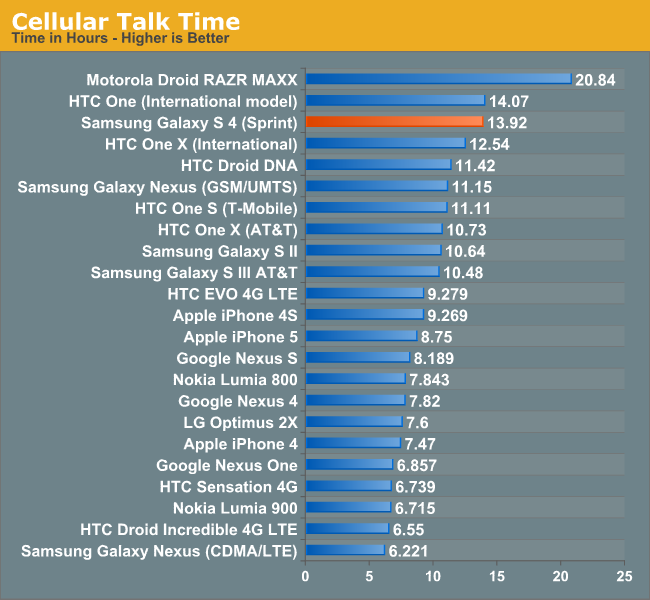
Talk time is excellent on the Galaxy S 4, with the phone delivering effectively the same battery life as the HTC One. Without having to power on that huge display, the Galaxy S 4 can last for a very long time on a single charge.
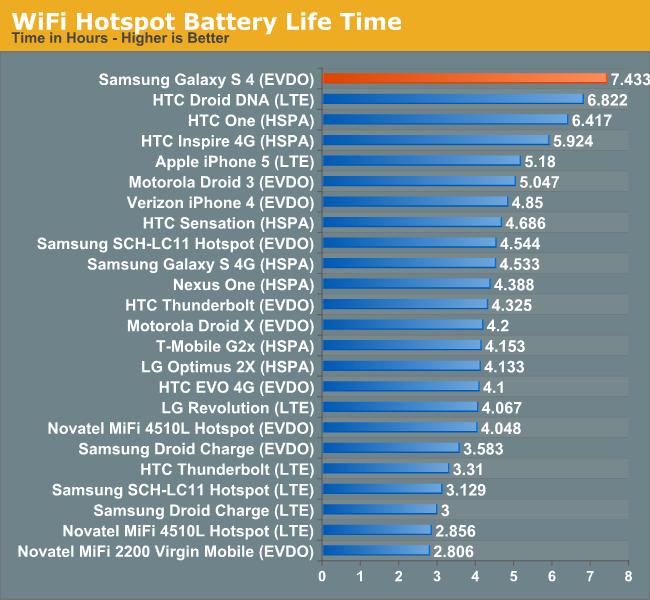
A combination of the Sprint network and the fact that the Galaxy S 4's display remains off during our hotspot test resulted in great battery life here as well. Again, this data isn't all that useful if you're not on Sprint but Samsung tells us we should be able to get our hands on an AT&T SGS4 in the not too distant future.
Charge Time
Samsung appears to implement Qualcomm's Quick Charge specification in the Galaxy S 4 and its bundled charger. I realize we haven't done a deep dive into what Quick Charge is and how it works, but I'll try to go through a quick explanation here. Most conventional chargers are linear, they take a fixed amount of input current (at 5V) and pass it along to the device being charged. The problem is that at deeply discharged states, the device's battery might be at a substantially lower voltage. A traditional linear charger won't change the current supplied based on the voltage of the battery being charged, and as a result can deliver sub-optimal charge times. When implemented, Qualcomm's Quick Charge technology can vary output current based on the voltage of the battery being charged, which results in less power being dissipated as heat and more being delivered to charging the battery itself. The table below helps illustrate the savings:
Quick Charge, at least in its currently available 1.0 specification, is still bound by the 5V limits of the USB BC 1.2 specification. The next revision of Quick Charge will enable higher voltage operation for even faster charge times.
| Qualcomm Quick Charge 1.0, Theoretical Example | ||||||
| Input Current @ Voltage | Input Power | Output Current @ Discharged Battery Voltage | Output Power | |||
| USB BC 1.2 - Linear Charger | 475mA @ 5V | 2.375W | 475mA @ 3V | 1.425W | ||
| Qualcomm Quick Charge 1.0 | 475mA @ 5V | 2.375W | 700mA @ 3V | 2.100W | ||
The non-linear nature of Quick Charge significantly shortens charge time, particularly in the very early stages of charging when the device's battery is presumably fully discharged. As the device's battery voltage increases, current delivery tapers off and the QC advantage is no longer as great as a standard USB BC 1.2 solution. The end result though is significantly improved charge times.
The graph below shows the benefits of using Samsung's own charger vs. a standard charger that implements the USB BC 1.2 specification. When used with the bundled charger, the Galaxy S 4 recharges much faster than HTC's One, despite using a larger battery. Obviously the Galaxy S 4 will charge with any USB charger, but the charge time will simply be longer. Samsung uses a voltage divider and signals the presence of their own charger by sending 1.2-1.3 V across the D+ / D- pins, this is similar to what Apple does with 2.0 or 2.8 V across the pins for various USB chargers they've shipped over the years. This signaling is essentially Samsung's proprietary tablet charging signaling which they've employed on the Galaxy Note 2 and now SGS4, in fact the two use the same exact charger, so it's worth tossing out your old ones and getting the appropriate one to take advantage of the faster charging.
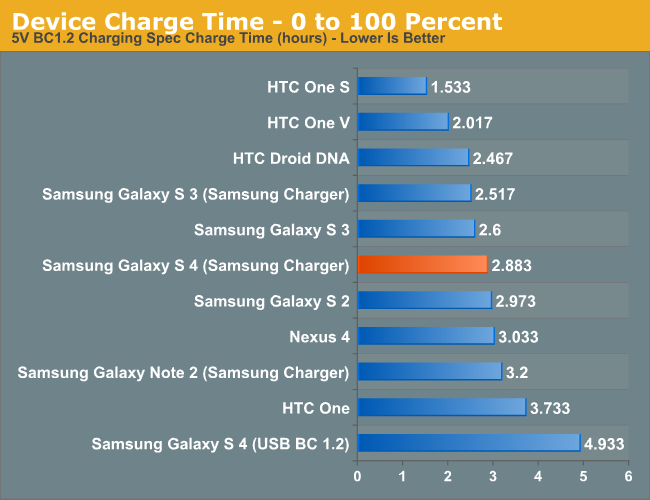


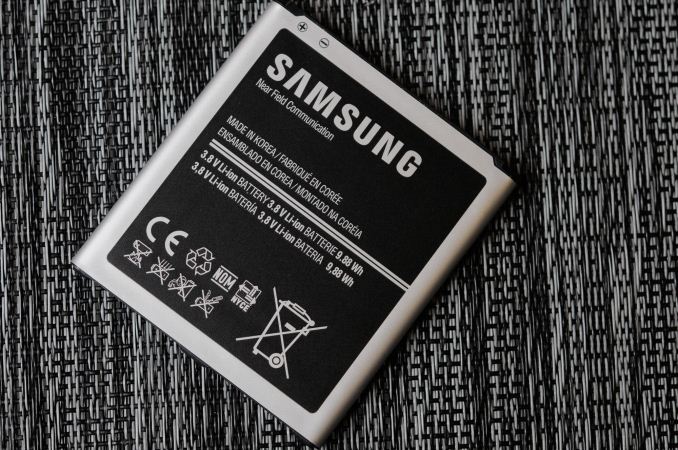








335 Comments
View All Comments
UpSpin - Thursday, April 25, 2013 - link
The camera in the One has an OIS, the LCD is brighter, has better color accuracy, better outdoor visibility and larger sub-pixels. The SoC is the same, just higher clocked in the S4, yet it overheats. Add this to overheating OLED and you won't be able to take advantage of the full power of both SoC and OLED in the S4 at intensive usage, like gaming. (just as written in this review). The UI is bloated with gimmicks which slow down the whole system and have to get deactivated to get a smooth experience back (just read the damn reviews).I agree that DDR3, micoSD Card, removeable battery and 2 panel multi-tasking is a plus for the S4.
As you see, both phones are impressive, both have their advantages and disadvantages.
nerd1 - Thursday, April 25, 2013 - link
Dpreview has done a proper comparison betwen phone cameras. Go and see how absolutuly pathetic One's camera looks compared to higher MP phones. And all the optional things are optional, which means you can turn off most stuff if you hate em.UpSpin - Thursday, April 25, 2013 - link
I read the review and it says what we know already:S4 is great at well and medium lit scenes. Thanks to 12MP it offers the most details there.
HTC One is great at darker scenes, has the best flash and thanks to OIS allows longer exposure times at night.
Or in the words of dpreview:
'None of the devices in this shootout are good at everything. So, if you're planning to take a lot of pictures with your smartphone, you should be clear about where your priorities are.'
My personal priorities:
Indoors or document scans, which means not well lit. If I go away on a sunny day I often take a real camcorder with me.
I agree that 4MP is very low, and 6MP or 8MP might have been better. But 4MP is not generally worse than 12MP, it's just a different approach for a different usage.
krumme - Thursday, April 25, 2013 - link
The One 4MP is plenty. People very seldom crop.But the optics is broken, shown by the extremely unsharp sides. Its unusable. Period. Its an error.
Secondly the sensor is simply bad. We get better lowlight ability in some situations and Brian have show the camera from its best side. Here comes the problems:
1. At night you will always use a HDR mode. No matter the phone. Using that the S4 gives superior pictures even at night.
2. The dynamics that was supposed to be better on the sensor of the Onejust didnt deliver. The sony sensor in the S4 despide smaller pixels, and smaller pixels than the S3/IP5 delivered the all important better dynamics here.
The Ones camera is a disaster from what it could have been. If sony had made a 4MP sensor the same size and Samsung implemented it, it would have been a blast and a revolution under all situations.
oshogg - Wednesday, April 24, 2013 - link
Does Galaxy S4 actually support UHS-1 speeds for the microSD slot? Were there any SD card read/write speed benchmark?Thanks,
Osho
Chaser - Wednesday, April 24, 2013 - link
Love my HTC One. Best phone I have had the pleasure to use.vision33r - Wednesday, April 24, 2013 - link
I don't have a problem with the plastic but the sheer number of Samsung phones that just look all a like.S4, S3, Note, Mini, etc all look a like just different sizes and SOC inside. Where is the premium Samsung phone? It has to look and perform top notch. The S4 maybe the flag ship phone but it looks like many of the Samsung cheaper variants.
slatanek - Wednesday, April 24, 2013 - link
Couldn't agree more. Even my HTC One SV looks and feels better than all the Sammy phones. I've had a Galaxy Note before and it didn't feel like a premium device at all, quite the opposite. It's interesting how many people don't care about the looks of a 600$ handset. I'm starting to think that Samsungs customers are uneducated and their only argument is about throwing their phones onto the pavement and how well plastic will bare. Funny enough in all drop tests I've seen (quite a few that is) Galaxy S3 lost to iPhone 5 (which is not plastic!). People tend to forget that it’s not only about the materials but the shape as well when it goes to dropping the phone. The rounded Samsungs shape doesn't distribute energy as evenly as the iPhone squareness does. Anyway, fact of the matter is they will sell millions but if Ford sell millions of cars does that mean there's no space for Porsche anymore? Hopefully not. Wouldn't like to wake up one day to find out that we live in a Samsung’s world (plastic nightmares anyone?) or any other company for that matter.Connoisseur - Wednesday, April 24, 2013 - link
OMG I need to buy one of these THIS WEEK. My Galaxy s3 with the official extended battery pack was stolen last week and I'm trudging along with an iphone 3gs in the meantime. LOVED the S3 with extended battery pack since it lasted me a day and a half with medium/heavy use and was still pretty damn thin. I didn't use any of the gimmicky options. While the HTC One looks sublime, i'm debating between that and a chance for an extended battery (and SD storage).nitenichiryu1 - Wednesday, April 24, 2013 - link
I'm currently using the i777 Galaxy S2, so both the HTC one and S4 are in the running for me. Currently I'm leaning towards the S4 because of the removable battery and microSD slot. Touchwiz vs. Sense isn't as big a deal for me since I'm going to root and rom Cyanogenmod 10.1.The only thing that I wish the S4 had isn't even the metal construction of the One, but the boomsound speakers!